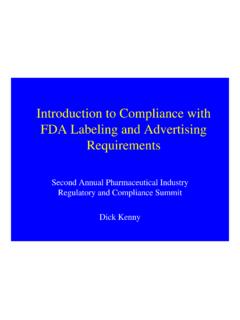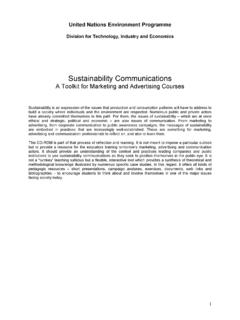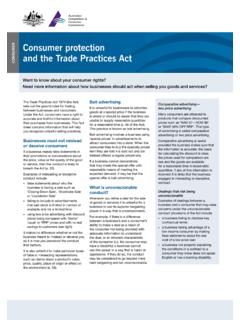Transcription of Guidelines for the Use of Comparative Advertising ...
1 April Standards CanadaGuidelines for the Use of Comparative AdvertisingAdvertising Standards Canada first published the Guidelines for the Use of Comparative Advertising and Guidelines for the Use of Research and Survey Data to Support Comparative Advertising Claims in 1982. They were designed to assist advertisers to develop Comparative Advertising that was consistent with the provisions of the Canadian Code of Advertising Standards. The Code is the Advertising industry s principal instrument of Advertising for the Use of Research and Survey Data to Support Comparative Advertising ClaimsAdvertising Standards Canada is grateful to the following industry leaders from the Advertising , legal and research sectors, who provided their advice and input to this revision to the Guidelines for the Use of Comparative Advertising and Guidelines for the Use of Research and Survey Data to Support Comparative Advertising Claims.
2 Ruth Corbin (Project Leader)Turkan AkturkRosanne AngottiCatherine BateGreg BiehnTim BowenJim BruceDanielle BushJanet CameronBarbara CaseSherry CaseyJoseph ChanSarah ChenowethRay ChepesiukJohn CoynePaul DillonDan EdmondstoneRafe EngleBrian FraserAnna Frost-HuntArlan GatesEric GlassMary GriffithChris HamiltonMarylou HilliardGillian HumphreysJohn JenkinsMichele KayRob KwinterPatti LartigueDayle LintonTom MaichScott MegginsonBarry MilavskyKelly MoffattJames B. MusgroveCarol NewellJayne PayetteBrenda PritchardSuzanne RaittRuth RapoportBob ReaumeGina RemyCarol RitterLinda RouletAndrea RushCatherine ShandTrish SimmieClare SmithJohanne TrudeauSusan VogtSandra WheatonTim WilsonTim WingroveGerry WrightJani YatesRobert ZielinskiThe Guidelines for the Use of Comparative Advertising and the Guidelines for the Use of Research and Survey Data to Support Comparative Advertising Claims are published by Advertising Standards Canada, the industry body committed to creating and maintaining community confidence in December 2005 Reprinted April 2012175 Bloor Street East South Tower, Suite 1801 Toronto, Ontario M4W 3R8 Telephone: 416 961-6311 Fax: 416 961-79042015 Peel StreetSuite 915 Montreal, Quebec H3A 1T8 Telephone: 514 931-8060 Fax: 514 931-2797 Advertising STANDARDS CANADAE-mail.
3 Web: Standards 1 1 Guidelines for the Use of Comparative 2 Guidelines for the Use of Research and Survey Data to Support Comparative Advertising 3 Stages of use for consumer research and survey Types of Testing perceived meaning or general impression of factual Principles of validity for Comparative Advertising Principles of reliability for Comparative Advertising 6 Advertising Standards CanadaTable Of ContentsFirst published in 1963, and regularly updated to keep it contemporary, the Code is administered by ASC, the industry body committed to creating and maintaining community confidence in Advertising . The Code sets the criteria for acceptable Advertising and forms the basis upon which Advertising is evaluated in response to complaints by consumers, advertisers or special interest groups.
4 (The Code is accessible on ASC s website at , or may be requested from ASC.)The Guidelines for the Use of Comparative Advertising and Guidelines for the Use of Research and Survey Data to Support Comparative Advertising Claims that follow are intended to assist users in understanding and applying the Code. It is important to note, however, that the Code takes precedence over the Guidelines . Failure to follow the provisions of the Guidelines will not, in and of itself, be deemed to be a breach of the Comparative Advertising is Advertising (as defined in the Code) that compares the advertiser s products or services, and the products or services of one or more identifiable organization(s) or of the marketplace as a whole, concerning, for example, product or service characteristics, value, performance, consumer preference, market share, sales origin or availability.
5 Advertising is defined in the Code as any message (the content of which is controlled directly or indirectly by the advertiser) expressed in any language and communicated in any medium to Canadians with the intent to influence their choice, opinion or behaviour. Excluded from the definition of medium and the application of the Code are:i) foreign media (namely media that originate outsideCanada and contain the Advertising in question)unless the advertiser is a Canadian person or entity;andii) packaging, wrappers and excluded from the application of the Code are political and election The Guidelines for the Use of Comparative Advertising and Guidelines for the Use of Research and Survey Data to Support Comparative Advertising Claims are intended to be compatible with, but not replace, the many laws and regulations that govern Advertising in Canada.
6 As well, these Guidelines do not apply to Comparative Advertising that is specifically regulated elsewhere for example: Advertising related to Comparative therapeutic claims for pharmaceutical products; and Comparative Advertising related to nutritional content of food and beverages regulated under the Food and Drugs Standards Canada (ASC) first published the Guidelines for the Use of Comparative Advertising and Guidelines for the Use of Research and Survey Data to Support Comparative Advertising Claims in 1982. They were designed to assist advertisers to develop Comparative Advertising that was consistent with the provisions of the Canadian Code of Advertising Standards (Code). The Code is the Advertising industry s principal instrument of Advertising self-regulation. Advertising Standards CanadaIntroduction1 | Advertising STANDARDS | The comparison must be a fair and factual comparison of similar properties, features, ingredients, benefits or performance between one product or service and one or more other products or services.
7 An advertisement must not create an unsupportable negative general impression of the compared-to product or service beyond the factual comparison being example, it would not meet the standard: To make a comparison with a competitor s productthat is no longer on the market. To make a claim that a product will last longer thana competitor s product when the products are ofdifferent sizes. To suggest that a competitor s product is significantlysmaller or less substantial when the difference isbarely discernible to | Other products or services must not be unfairly discredited or disparaged by a claim specifically made in an example, it would not meet the standard: To make an unsubstantiated claim that Service X stechnology is inferior to Service Y s, when it is not. To claim that a competitor, who is new to a market, isless reliable than the advertiser, simply because it isnew to the market.
8 To make an unsubstantiated claim that a competitor sproduct is less dependable than the advertiser | Other products or services must not be unfairly discredited or disparaged through the general impression conveyed by an should avoid visual imagery that might leave an unwarranted negative general impression of other products or example, it would be unfairly discrediting or disparaging: To imply overall product inferiority by showing aconsumer tasting the other product and grimacing toindicate dislike or disgust. To show another product being abused or in anabused state, such as being thrown, trampled,distorted. To show another product used in a way other than asrecommended by the manufacturer. To exaggerate the difficulty of using another productor service, when the difference is barely discernible | Selected comparisons of specific features or attributes should not be used to claim or imply overall superiority, without factual support that such a link is example, it would not meet the standard: To claim a product is better or best based only onsales results.
9 To claim overall superiority of performance by a spotremover when research data only prove superiority ineliminating two of many different types of stains. To claim better value for an unconcentrated laundryproduct, based on its bigger box and volume, whenthe concentrated product, for the same cost, candeliver the same or more wash | Statements about compared products or services delivered through a testimonial or by a spokesperson should be clearly presented as an individual opinion, unless reliable and valid research or survey data exists to support such statements or claims. | For Comparative Advertising claims that depend on research or survey data for their support, it is recommended that advertisers follow ASC s Guidelines for the Use of Research and Survey Data to Support Comparative Advertising | Advertisers involved in an Advertising dispute conducted pursuant to ASC s Advertising Dispute Procedure (formerly called the Trade Dispute Procedure) must provide to ASC adequate support for their Advertising claims when requested to do so by ASC.
10 Such support may also be requested by ASC in connection with a consumer s complaint pursuant to ASC s Consumer Complaint Procedure. Advertising Standards CanadaGuidelines for the Use of Comparative AdvertisingADVERTISING STANDARDS CANADA | INTRODUCTION When a Comparative claim is planned or advertised, or when an Advertising dispute is submitted to ASC under its Advertising Dispute Procedure, survey data may be helpful or necessary. The Guidelines for the Use of Survey and Research Data to Support Comparative Advertising Claims are intended to be compatible with the code(s) of conduct adopted by the Marketing Research and Intelligence Association of Canada ( ).The Guidelines for the Use of Research and Survey Data to Support Comparative Advertising Claims apply to all methodologies by which research and survey data may be collected, and provide standards to meet a high burden of proof for supporting Comparative Advertising STAGES OF USE FOR CONSUMER RESEARCH AND SURVEY DATA Advertisers should consider using research to support Comparative Advertising claims in at least three instances: At the stage of investigating whether a Comparative claim is justified.








